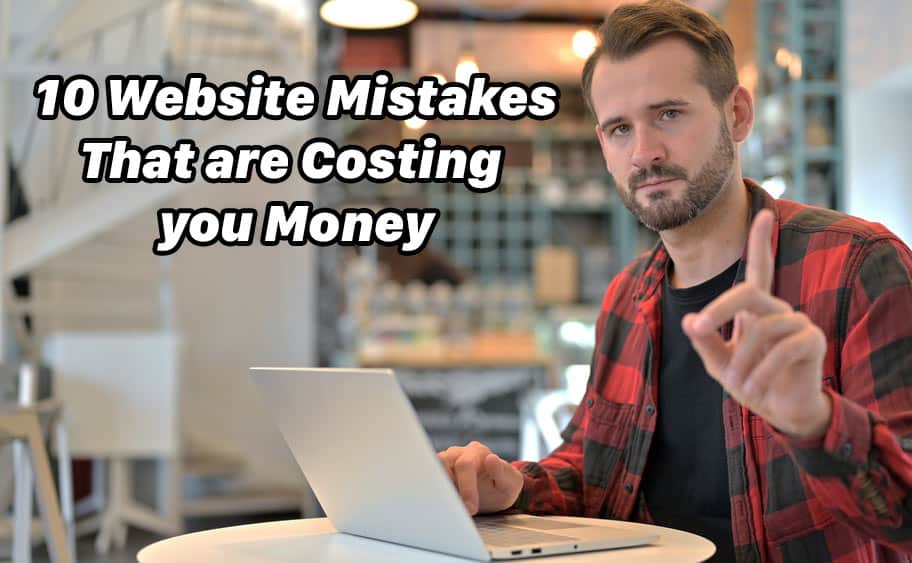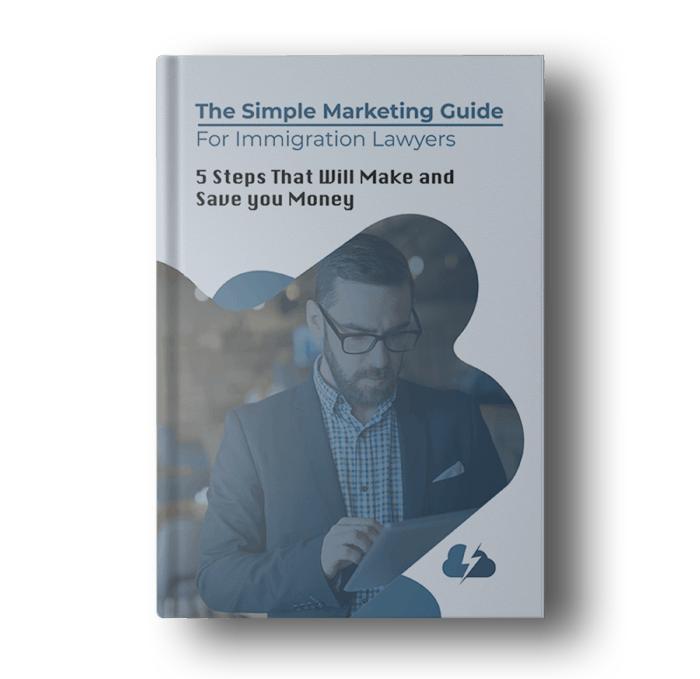Your website is often the first impression potential customers have of your business. It’s your digital storefront, your 24/7 salesperson, and a crucial tool in converting visitors into loyal clients. But just like a cluttered, confusing, or outdated physical store can drive customers away, poor web design can do the same online.
Business owners often focus on having an online presence without realizing that *how* their website is designed can make or break their success.
If your site is difficult to navigate, slow, or visually unappealing, customers will leave before they even see what you offer.
In this article, we’ll cover 10 website mistakes which are most common that businesses make, how they can hurt your bottom line, and what you can do to fix them.
1. Cluttered Layouts – Less Is More
The Mistake:
Many businesses try to cram too much information onto a single page—text, images, videos, promotions, pop-ups—all competing for attention. The result? A chaotic experience that overwhelms visitors.
Why It’s a Problem:
A cluttered website confuses users, making it hard for them to find what they need. When people feel lost or overwhelmed, they leave, leading to high bounce rates and lost sales.
The Fix:
Simplify your layout. Use white space to create breathing room, focus on clear headings, and only include essential information. Keep your call-to-action (CTA) prominent so visitors know exactly what to do next—whether it’s signing up for a newsletter, booking an appointment, or making a purchase.
2. Confusing Navigation – Make It Easy to Find Everything
The Mistake:
If users have to hunt for important information like contact details, product pages, or pricing, they’ll get frustrated and leave.
Why It’s a Problem:
Confusing navigation leads to lost sales. People don’t want to click through endless menus or play a guessing game to find what they need.
The Fix:
Stick to a clear, user-friendly menu. Categories should be logical and intuitive, and every page should be reachable in just a few clicks. If you have a large site, consider a search bar to help users find what they need quickly.
3. Outdated Design – Keep Up with the Times
The Mistake:
Websites that look like they were built in the early 2000s with outdated fonts, colors, and layouts give the impression that your business is behind the times.
Why It’s a Problem:
People associate a business’s professionalism and credibility with its website. If your site looks old or neglected, potential customers may think your products or services are not the best and outdated too.
The Fix:
Regularly update your website’s design to keep it fresh and modern. Use clean, contemporary fonts, mobile-friendly layouts, and high-quality images. If your website hasn’t been redesigned in over five years, it’s time for an upgrade.
4. Not Mobile-Friendly – The Majority of Users Are on Their Phones
The Mistake:
A website that isn’t optimized for mobile devices will look broken, with text too small to read and buttons too tiny to tap.
Why It’s a Problem:
More than half of web traffic comes from mobile devices. If your website isn’t mobile-friendly, you’re driving away potential customers.
The Fix:
Make sure your website is mobile ready and uses responsive design, meaning it adjusts automatically to different screen sizes. Test your site on various devices to ensure a smooth user experience everywhere.
5. Slow Load Times – Speed Matters
The Mistake:
If your website takes more than a few seconds to load, people will leave before they even see your content.
Why It’s a Problem:
Slow websites not only frustrate users but also rank lower on Google, making it harder for potential customers to find you.
The Fix:
Optimize your images, use a fast web hosting service, and minimize unnecessary code or plugins. Google’s PageSpeed Insights tool can help diagnose speed issues.
6. Poorly Written Content – Keep It Clear and Concise
The Mistake:
Walls of text, jargon-heavy descriptions, or unclear messaging make it difficult for visitors to understand what your business offers.
Why It’s a Problem:
People don’t read—they scan. If they can’t quickly grasp what you do and why it matters, they’ll move on.
The Fix:
Write in a clear, engaging way that speaks directly to your audience. Use bullet points, short paragraphs, and simple language. Make sure your headlines and CTAs stand out.
7. No Clear Call-to-Action – Guide Your Visitors
The Mistake:
Visitors land on your site, but they don’t know what to do next. Should they contact you? Buy something? Sign up for a free trial?
Why It’s a Problem:
If you don’t tell people what action to take, they won’t take any action at all.
The Fix:
Make your CTAs bold and clear. Every page should have a purpose—whether it’s booking a service, filling out a contact form, or making a purchase.
8. Ignoring SEO – Be Found on Google
The Mistake:
A beautiful website is useless if no one can find it. Many businesses fail to optimize their site for search engines.
Why It’s a Problem:
Without proper SEO (Search Engine Optimization), your website won’t appear on Google’s first page, meaning potential customers will go to your competitors instead.
The Fix:
Use relevant keywords, write informative blog posts, and ensure your website is technically optimized for search engines. If SEO seems complicated, hiring an expert can be a game-changer for your business.
9. Lack of Trust Signals – Build Credibility
The Mistake:
No testimonials, reviews, or trust badges make visitors hesitant to do business with you.
Why It’s a Problem:
People want proof that your business is reliable before they commit.
The Fix:
Showcase customer reviews, testimonials, and any certifications or awards you’ve received. Adding trust badges (like secure payment logos) can also increase conversions.
10. No Contact Information – Make It Easy to Reach You
The Mistake:
Some websites bury their contact details or don’t have them at all.
Why It’s a Problem:
If potential customers can’t easily reach you, they’ll go elsewhere.
The Fix:
Place your contact information in an easy-to-find spot, like the header or footer. Include multiple ways to reach you—phone, email, and even live chat if possible.
Final Thoughts
Your website should work *for* your business, not against it. Avoiding these common mistakes will help you attract more visitors, keep them engaged, and turn them into paying customers.
If your website isn’t performing as well as it should, now is the time to make changes.
At Ravecode solutions we focus on building a well-designed, user-friendly site that can be one of your most powerful business assets.
Whether you’re redesigning an existing website or building one from scratch, we can help your business get to that next level, however, if you want to do this yourself, keeping these best practices in mind will set you up for success.
Remember: Your website is your business’s digital handshake—make it count!
The Synergy Between Great Design and Search Engine Visibility
Why Great Design Alone Isn’t Enough
Think of your website as a digital storefront. You might have the most beautiful window displays, modern décor, and friendly staff—but if no one knows you exist, you’ll struggle to get traffic through the door.
That’s where search engine visibility comes in. Good design captures attention and helps convert visitors into customers, but visibility brings them in the first place.
Why SEO Alone Isn’t Enough
On the flip side, imagine a store that’s on the most popular street corner in town (high online visibility). If the interior is disorganized, products are difficult to find, and the space is poorly lit, customers won’t stay long.
They’ll head to a competitor who offers a smoother, more enjoyable experience.
SEO alone might drive traffic to your site, but if people arrive and find it ugly, slow, or confusing, they’ll bounce back to Google in a heartbeat.
That’s a lost sale—and a damaging signal to search engines that your page wasn’t helpful.
The Magic Happens When Design and SEO Collide
When you strike the perfect balance between an appealing design and strong search visibility, you create a powerful online presence that:
- Draws people in: You appear in relevant searches, and your website looks professional.
- Keeps them engaged: Once visitors arrive, they’re greeted by a user-friendly layout that guides them seamlessly through your offerings.
- Converts them into customers: Trust is built from the moment they land on your site, increasing the chance of a sale or inquiry.
It’s this synergy—the meeting point of aesthetics and functionality—that ultimately drives business growth.
You get to show off your brand’s personality while making it incredibly straightforward for potential buyers to find and interact with you.
The Three Pillars of SEO-Friendly Web Design
While you don’t need to become a tech expert, it helps to understand the broad strokes of what makes a website “SEO-friendly.” Most of it boils down to these three pillars: on-page SEO, clean code, and site structure.
On-Page SEO
- Titles & Descriptions: Each page has a title (the main headline you see in search results) and a meta description (the short snippet explaining what’s on the page). These both help Google and visitors quickly see the purpose of the page.
- Keywords: Think about the words or phrases your customers might type into Google when searching for businesses like yours. Include these naturally in your page content, headings, and even image descriptions.
- Fresh Content: Updating your site periodically with new or refreshed content—like blog posts, FAQs, or service pages—shows search engines you’re active and relevant.
Clean Code
- Speedy Load Times: Bloated, messy code can slow your site’s loading speed, frustrating visitors and hurting your rankings.
- Mobile Responsiveness: A site that automatically adjusts to screen sizes (smartphone, tablet, desktop) is essential for modern SEO.
- Secure Connections (HTTPS): Secure sites (that start with “https”) instill confidence in users and are favored by Google.
Logical Site Structure
- Easy Navigation: Group pages by category, so visitors can intuitively find what they need.
- Internal Linking: Linking from one page to another within your own site helps visitors (and Google) discover more of your content.
- Short, Clear URLs: Use human-readable URLs—like yoursite.com/products/red-umbrella—instead of random strings of letters and numbers.
The Real-World Benefits (and Results) for Business Owners
Now that we’ve covered the basics, let’s drill down on why you, as a business owner, should truly care.
Below are the tangible ways SEO-friendly web design can transform your business and deliver substantial returns.
More Targeted Traffic
What It Means: Targeted traffic consists of visitors who are already interested in your product or service. They’re not just random folks stumbling in; they’re people who searched for the exact things you offer.
- How You Benefit: Higher odds of conversion. If someone searched “best running shoes for flat feet,” clicked on your site, and found a page dedicated to that very topic, they’re much more likely to buy.
Higher Conversion Rates
What It Means: A conversion can be anything from a sale to a sign-up for your newsletter or a request for a quote. It’s basically how you measure success on your site.
- How You Benefit: By marrying good design (easy navigation, appealing visuals, trust-building elements) with SEO (bringing the right people in), you increase the percentage of people who take the action you want.
Better Brand Perception
What It Means: When potential customers land on a sleek, modern site that’s also easy to find, it subtly tells them you’re reputable, organized, and “on top of things.”
- How You Benefit: Credibility is everything in the online world. A visitor who trusts you is more likely to move forward with a purchase, hire you for a service, or recommend you to a friend.
Reduced Reliance on Paid Advertising
What It Means: With stronger organic search presence, you may not have to rely as heavily on paid ads (Facebook ads, Google Ads, etc.) to drive business.
- How You Benefit: Lower marketing costs and more sustainable traffic. While you might still use some paid advertising, you won’t be solely dependent on it.
Enhanced Customer Experience
What It Means: SEO-friendly design usually goes hand in hand with a user-friendly experience, which includes clear navigation, responsive layouts, and fast load times.
- How You Benefit: Satisfied customers are more likely to make repeat visits, buy more products, and leave positive reviews. Plus, good user signals (like longer visit duration) help Google see your site as valuable, reinforcing your rankings.
Deeper Insights into Your Audience
What It Means: SEO-friendly sites often use tools like Google Analytics to track user behavior. This can tell you which pages people like most, how they found you, and what they do once they land on your site.
- How You Benefit: More data = more informed decisions. If you notice that a particular blog post gets loads of traffic, you might expand that topic further or create related products. If visitors leave quickly from a certain page, you can investigate why and improve it.
Long-Term Return on Investment
What It Means: Unlike short-term marketing tactics (like a newspaper ad or a short social media campaign), optimizing your site for search engines and user experience can pay off for years to come.
- How You Benefit: Each page you optimize can continue to attract new visitors month after month without requiring constant spending. Over time, you’ll build a significant online presence that competitors who ignore SEO will struggle to match.
Overcoming Common Hurdles
Despite the clear benefits, some business owners still hesitate to invest in SEO-friendly web design. Let’s tackle a few common objections:
“I’m Not Tech-Savvy”
You don’t have to be a coding expert to reap the rewards of a well-optimized site. You just need to know enough to hire the right people or ask the right questions. Think of it like hiring an accountant—you don’t have to be a tax whiz to benefit from professional help.
“It Costs Too Much”
While there’s definitely an up-front investment in web design and SEO, the long-term ROI often outweighs initial costs. A well-built site that ranks organically can save you thousands of dollars on paid advertising in the future.
“I Don’t Have the Time”
The beauty of a well-optimized site is that, once it’s set up properly, it continues working for you even when you’re not actively involved. Yes, ongoing tweaks and content updates help maintain your rankings, but you won’t need to dedicate all your waking hours to it.
Practical Next Steps for Busy Business Owners
- Start with an Audit
Ask a web agency or consultant to look at your current site. They’ll identify areas that need improvement—from design hiccups to slow load times or poor SEO fundamentals.
- Focus on Quick Wins
- Update Titles & Meta Descriptions: These small tweaks can make a noticeable difference in how your pages appear in search results.
- Check Mobile Responsiveness: View your site on a phone or tablet to ensure it’s user-friendly.
- Prioritize User Experience
- Speed Up Your Site: Compress large images, remove outdated plugins, and consider better hosting if your current one is slow.
- Streamline Navigation: Make sure your main menu is intuitive and free of clutter.
- Create (or Update) Content
- Answer Common Questions: Publish short articles, FAQs, or videos that address questions your customers frequently ask.
- Stay Current: Regularly update your site so visitors see it’s active and Google notices fresh content.
- Monitor and Adjust
- Set Up Basic Analytics: Even a simple dashboard can tell you which pages get the most visits, where your traffic comes from, and what leads people to leave.
• Tweak and Improve: Based on the data, refine your site layout, calls to action, or keyword usage.
Final Thoughts: Make Your Website Work for You
As a business owner, you have a lot on your plate—managing finances, overseeing staff, serving customers.
But your website is an employee that works 24/7, potentially reaching hundreds or thousands of customers each day. Why not ensure it’s doing the best job possible?
An SEO-friendly design doesn’t just make Google happy; it makes your customers happy, too.
At Ravecode Solutions, we focus our web design on helping your customers find you easily, navigate your site effortlessly, and trust your brand from the moment they arrive.
We will focus on:
- Greater Visibility: More potential customers see your site in search results.
- Better User Experience: People enjoy browsing, stay longer, and are more likely to convert into leads or sales.
- Stronger Brand Impression: A sleek, professional look and feel positions you as a credible authority in your industry.
- Increased ROI: Over time, your initial investment in SEO and design can yield compounding returns, generating consistent traffic and sales with minimal extra spending.
Remember: Good web design and SEO aren’t about gaming the system; they’re about putting your best foot forward so that search engines can accurately represent your business to the right audience.
When done thoughtfully, it’s a win-win: you help potential customers find exactly what they need, and you grow your business in the process.
Ready to Take the Next Step?
If you’re feeling inspired to make your website work harder for you, start by evaluating your current site’s performance.
Reaching to our team at Ravecode Solutions. With a vast experience in web design and SEO specialists who understands how to blend visual appeal with search optimization. Even a few targeted improvements can yield noticeable results, from higher rankings to happier customers.
Ultimately, SEO-friendly web design is about creating a positive experience for both search engines and real people—because, at the end of the day, your business thrives when genuine customers find real value on your site.
By striking the right balance between beauty and function, you’ll build a digital presence that truly supports and grows your business.







